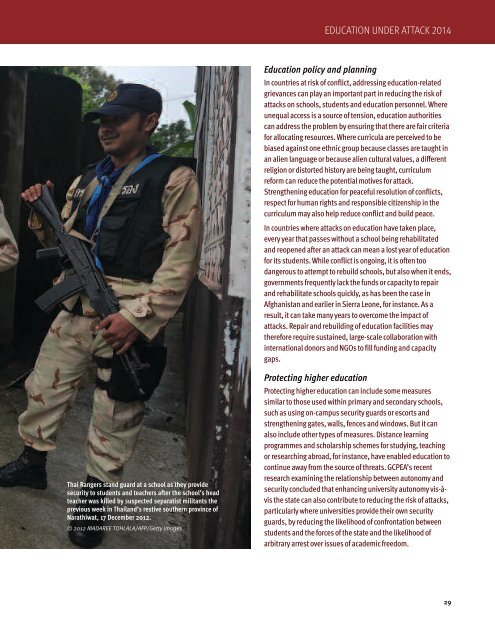You also want an ePaper? Increase the reach of your titles
YUMPU automatically turns print PDFs into web optimized ePapers that Google loves.
EDUCATION UNDER ATTACK 2014<br />
Education policy and planning<br />
In countries at risk of conflict, addressing education-related<br />
grievances can play an important part in reducing the risk of<br />
attacks on schools, students and education personnel. Where<br />
unequal access is a source of tension, education authorities<br />
can address the problem by ensuring that there are fair criteria<br />
for allocating resources. Where curricula are perceived to be<br />
biased against one ethnic group because classes are taught in<br />
an alien language or because alien cultural values, a different<br />
religion or distorted history are being taught, curriculum<br />
reform can reduce the potential motives for attack.<br />
Strengthening education for peaceful resolution of conflicts,<br />
respect for human rights and responsible citizenship in the<br />
curriculum may also help reduce conflict and build peace.<br />
In countries where attacks on education have taken place,<br />
every year that passes without a school being rehabilitated<br />
and reopened after an attack can mean a lost year of education<br />
for its students. While conflict is ongoing, it is often too<br />
dangerous to attempt to rebuild schools, but also when it ends,<br />
governments frequently lack the funds or capacity to repair<br />
and rehabilitate schools quickly, as has been the case in<br />
Afghanistan and earlier in Sierra Leone, for instance. As a<br />
result, it can take many years to overcome the impact of<br />
attacks. Repair and rebuilding of education facilities may<br />
therefore require sustained, large-scale collaboration with<br />
international donors and NGOs to fill funding and capacity<br />
gaps.<br />
Thai Rangers stand guard at a school as they provide<br />
security to students and teachers after the school’s head<br />
teacher was killed by suspected separatist militants the<br />
previous week in Thailand’s restive southern province of<br />
Narathiwat, 17 December 2012.<br />
© 2012 MADAREE TOHLALA/AFP/Getty Images<br />
Protecting higher education<br />
Protecting higher education can include some measures<br />
similar to those used within primary and secondary schools,<br />
such as using on-campus security guards or escorts and<br />
strengthening gates, walls, fences and windows. But it can<br />
also include other types of measures. Distance learning<br />
programmes and scholarship schemes for studying, teaching<br />
or researching abroad, for instance, have enabled education to<br />
continue away from the source of threats. GCPEA’s recent<br />
research examining the relationship between autonomy and<br />
security concluded that enhancing university autonomy vis-àvis<br />
the state can also contribute to reducing the risk of attacks,<br />
particularly where universities provide their own security<br />
guards, by reducing the likelihood of confrontation between<br />
students and the forces of the state and the likelihood of<br />
arbitrary arrest over issues of academic freedom.<br />
29



